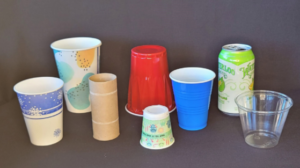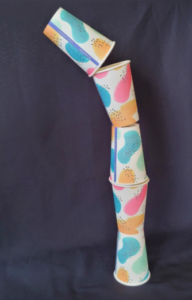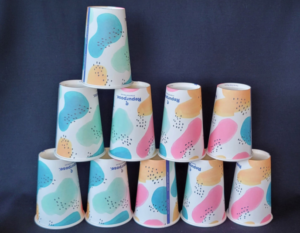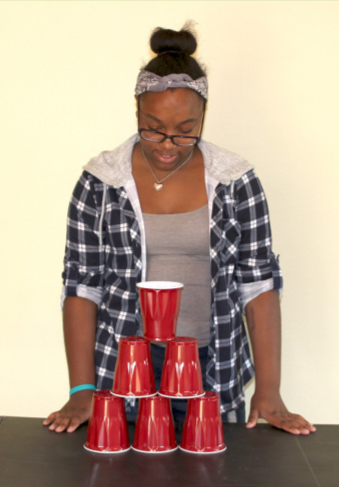Overview
STEM careers
Topic
Time
Materials
Per Team:
 Large paper or plastic cups of uniform size, 100 per team (12 oz or 16 oz are best)
Large paper or plastic cups of uniform size, 100 per team (12 oz or 16 oz are best)- Alternative materials: empty soda cans, dixie cups, rolls of toilet paper, round plastic plant pots
- Consider various factors when choosing your materials:
- Paper cups are compostable, while plastic cups are more resistant to denting and can be used for many years.
- Paper cups have narrow-edged bottoms, while plastic cups have flat bottoms.
- Other variables include the weight and coefficient of friction of the building materials.
Instructions
DEFINE THE PROBLEM
-
 Place an upside-down cup where students can see it. Place a right-side-up cup on top of it so that the bottom of the second cup rests on the bottom of the first cup. Ask students, “How many cups do you think we can add to these two before the tower falls over?” Take some guesses from students before starting to add cups. Continue adding cups until the tower topples. Once it does, ask students why they think that happened. As needed, paraphrase students’ speculations by using the terms stability and balance. Tell them that their challenge is to make a tower as tall as possible, but that won’t fall over.
Place an upside-down cup where students can see it. Place a right-side-up cup on top of it so that the bottom of the second cup rests on the bottom of the first cup. Ask students, “How many cups do you think we can add to these two before the tower falls over?” Take some guesses from students before starting to add cups. Continue adding cups until the tower topples. Once it does, ask students why they think that happened. As needed, paraphrase students’ speculations by using the terms stability and balance. Tell them that their challenge is to make a tower as tall as possible, but that won’t fall over. - Give students the specs:
- The tower must stand on its own without any human assistance.
- The only materials you can use are the cups themselves.
- You can configure the cups any way you want.
- You can use up to 100 cups (or 50 for younger students).
- Add a time constraint, such as 15 minutes.
-
 Divide the class into small teams. Tell them to spend a few minutes trying out different arrangements of cups to get ideas for which design would work best. Call attention to the teams who are experimenting with making the base layer of cups bigger than the layers above. Ask them to explain their reasoning before noting that a broader base can create strength and stability for the layers above. Encourage all teams to try out different configurations for the bases of their towers.
Divide the class into small teams. Tell them to spend a few minutes trying out different arrangements of cups to get ideas for which design would work best. Call attention to the teams who are experimenting with making the base layer of cups bigger than the layers above. Ask them to explain their reasoning before noting that a broader base can create strength and stability for the layers above. Encourage all teams to try out different configurations for the bases of their towers. - Give students the signal to start building their towers. Let them know when they only have a couple of minutes left to build. When the time is up, see which team built the highest stable tower.
- Ask teams to share their design strategies: What worked and what didn’t? Note that the towers that toppled provide valuable information for what to avoid when building for stability. Engineers rely on learning from their mistakes! Take suggestions for how those towers could be improved.
- Give teams another chance to build towers even higher. You may also have students try their design with a different set of materials to see how it affects tower stability.
BRAINSTORM SOLUTIONS
BUILD AND TEST
EVALUATE AND REDESIGN
Guiding questions
-
What happens if the tower base is the same width as the rest of the tower?
-
What if the tower base is a different size and/or shape from other parts of the tower?
-
How can the cups best be arranged to help hold each other in place?
-
How can the cup edges be used to create the most stability?
Engineering & science connections
- Before the 1800s, the only way to build up was to make the walls of the lowest floors very thick so that the lower floors could support the weight of the upper floors. This method didn’t work for building very many floors. It took engineers to develop the breakthrough that led to the building of skyscrapers. They discovered that long beams of solid iron made great support structures: they are a lot lighter than solid brick walls and take up much less space too. Better yet, engineers created steel beams, which are even lighter and stronger than iron, and buildings could get even taller.
- Building a tower involves working with the force of gravity. Gravity is what keeps us, and everything else, from floating around. It is a pulling force, and it’s why things fall down toward the center of the Earth’s mass. Sir Isaac Newton was the first person to realize that every object in the universe pulls on every other object; he wrote about it in 1687. And even though scientists have been studying gravity ever since, they are still trying to understand it better.
- The towers that did not topple over are balanced. Their balance points, or center of mass, are directly over the base. In order to ride a bike without falling over, we need to find our center of mass too. We can feel it when we’ve lost that center—and we fall off our bikes. The lower the center of gravity, the easier it is to keep our balance, and the easier it is to prevent a tower from toppling over.
- Architectural engineers are among the newest kinds of engineers to emerge within the last century. Their specialty is designing and making buildings that are more environmentally sustainable by using cutting-edge technology.


0 Comments